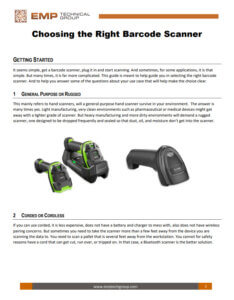Getting Started
It seems simple, get a barcode scanner, plug it in and start scanning. And sometimes, for some applications, it is that simple. But many times, choosing the right barcode scanner is far more complicated. This guide is meant to help you select the right barcode scanner for the job. And to help you answer some of the questions about your use case that will help make the choice clear.
1 – General Purpose or Rugged
This mainly refers to handheld scanners, will a general-purpose hand scanner survive in your environment. The answer is many times yes. Light manufacturing, very clean environments such as pharmaceutical or medical devices might get away with a lighter grade of scanner. But heavy manufacturing and more dirty environments will demand a rugged scanner, one designed to be dropped frequently and sealed so that dust, oil, and moisture don’t get into the scanner.
2 – Corded or Cordless
If you can use corded, it is less expensive, does not have a battery and charger to mess with, and does not have wireless pairing concerns. But sometimes you need to take the scanner more than a few feet away from the device you are scanning the data to. You need to scan a pallet that is several feet away from the workstation. You cannot, for safety reasons, have a cord that can get cut, run over, or tripped on. In that case, a Bluetooth scanner is the better solution.
3 – Hands Free
Maybe your application will allow the scanner to stay stationary and you can present the product with the barcode to the scanner. This keeps both hands free, so your operator is the most effective. There are scanners designed to mainly be stationary with some sort of a stand built in. Or there are stands so that you can take a normal handheld scanner and put it into the stand for hands free scanning.
4 – Wearable Scanners
Usually these are ring scanners, but there are some back of hand scanners available as well. Originally these scanners were designed to work with wearable mobile computers only. But the use cases for pairing these Bluetooth scanners with tablets, laptops, cell phones, even stationary PC’s are prevalent. Any time that hands free scanning where you are mobile is needed, a wearable scanner should be a consideration.
5 – Long-Range, Mid-Range, or Short-Range
Mid-Range is the new phrase in the marketplace here. Historically, in order to get a long-range imager, you had to get the most rugged mobile computer or hand scanner. Getting long range imagers in a tablet or touch computer was not an option. The users of long-range barcode scanners were mainly in the warehouse. Operators who needed to scan location barcodes from a long distance, or any barcode from the seat of a forklift without having to get up and off the forklift repeatedly. Battery power was the main driver for this type of scanner, only being available in the more rugged devices. The latest long-range imagers are two imagers in one which means that their power consumption is high.
The Mid-Range scanner is a relatively new product. Not quite as good as the long-range, but still pretty good range, but with much lower power requirements. This has helped the tablets and touch computers find more applications because of the new availability of mid-range scanners.
6 – Barcodes Printed on Paper or Direct Part Marks
This can be tricky. Most barcodes that are scanned are printed on paper, or labels with high resolution printers. These barcodes have lots of contrast between the bars, or elements of the barcode, and the white background. But more and more common are barcodes that are printed or etched directly onto metal or plastic (direct part marking). These can be a challenge to read and need special barcode scanners to read them. Both handheld and fixed mount scanners are available to read these codes, but some work needs to go into specifying and configuring the scanners to read reliably.
7 – Fixed Scanners
Now the lifting gets heavy. Lighting, lenses, mounting, pixel count, pixels per module, in motion or stationary. All these factor into selecting not only the right scanner, but the right scanning system for your application. We have an entire lab set up and in-house conveyors to help us evaluate fixed scanning needs and the products needed to successfully scan the product every time. We have multiple brands to choose from and can help you engineer the scanning system needed for your application.
8 – Conclusion
As you can see, there is more here than meets the eye. Laser scanners are long dead and there is a lineup of barcode imagers to meet your scanning needs. Be they corded, cordless, hands free, long-range, mid-range, fixed or mobile.
One thing is for sure, you need an honest and experienced partner when it comes to choosing the right barcode scanner. You want the EMP Tech Group on your team!
